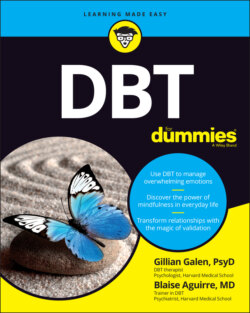Читать книгу DBT For Dummies - Gillian Galen - Страница 21
Understanding Dialectical Behavior Therapy
ОглавлениеIN THIS CHAPTER
Examining the biosocial theory behind DBT
Getting into the goals and functions of DBT
Exploring DBT treatment modes
Digging into the dialectical process
Dialectical behavior theory (DBT) was initially developed by Marsha M. Linehan, Ph.D., a psychologist at the University of Washington, to help adult women with a condition known as borderline personality disorder (BPD). BPD is characterized by intense swings in emotions, difficulties with intimate and close relationships, self-destructive behavior, and at times suicidal behavior. For many people with BPD, the possibility of death by suicide makes it one of the most difficult of mental health conditions to treat. In fact, before DBT, BPD was considered a uniquely difficult psychiatric condition to treat; neither medications nor psychotherapy seemed to provide any kind of immediate relief.
However, because people who were suicidal were not “just” suicidal but also had many other problems, having a therapy that dealt with all of a person’s problems was essential to having a comprehensive, supportive, and successful treatment. Further, the treatment needed to be useful to both patient and therapist, because many therapists would often find themselves terrified of treating suicidal patients, and so they also needed support.
Enter DBT. In this chapter, you discover the basics of this therapy, including the biosocial theory, treatment functions and goals, modes of treatment, and the dialectical process.
